Example CustomerIsuzu Motors Headquarters
A flexible community space that feels spacious
and rises above a typical staff cafeteria
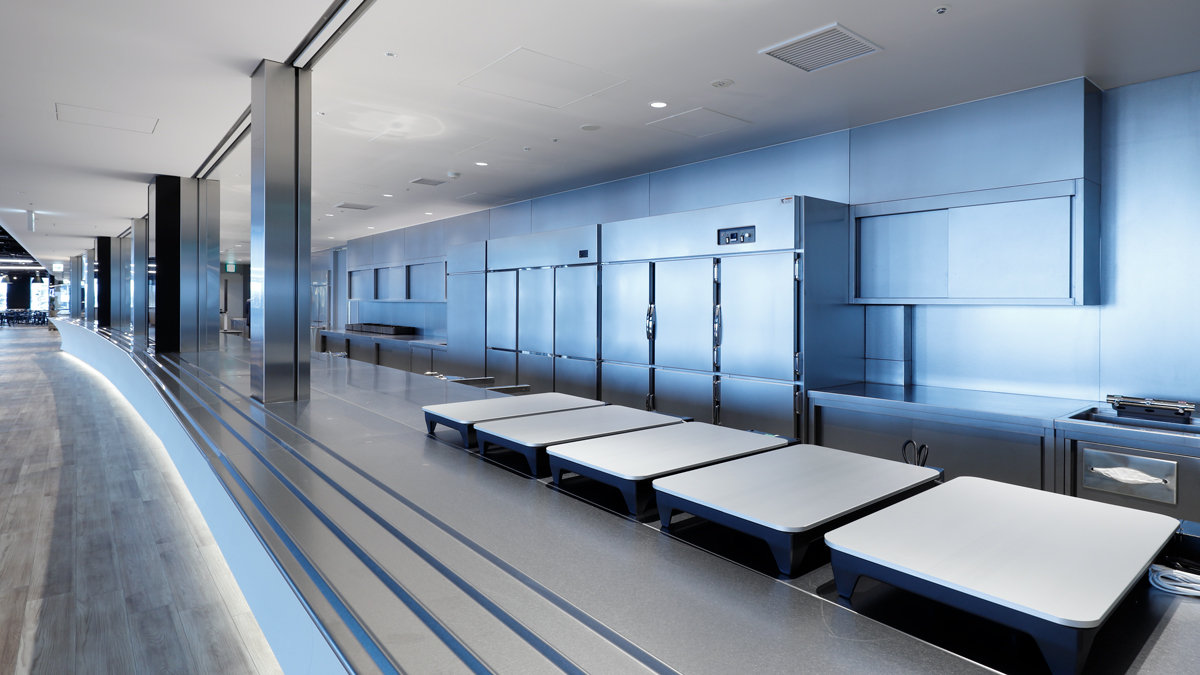
The food serving counter, which spans approximately 80 meters in width. The main kitchen is tucked behind a wall of refrigerators.
Isuzu Motors Limited relocated its headquarters from Omori, Tokyo where it was founded, to Yokohama in May 2022. It created a space informally called “Yokohama Terrace” at the new location, which is very popular among employees. The over 3,500-square-meter floor is divided into zones and serves as not only a company cafeteria but also a communication and working space. In response to the plan for this space to encourage new work styles, Fujimak was among the first to deliver next-generation equipment that contributes to labor savings. This equipment includes “finibo,” an automatic dishware sorting robot, and an “autonomous transport trolley,” a self-driving robot that delivers dishware to distant locations on the floor.
“A space where people can gather freely and find a place to belong”
On May 9, 2022, Isuzu Motors, along with many affiliated companies, moved its headquarters from Omori, Tokyo, to the Yokohama Gate Tower in the Minato Mirai district of Yokohama. On the 8th floor of the new building, “Yokohama Terrace,” a multi-purpose space with over 3,500 square meters of floor space and a seating capacity of 640, is now open.
In addition to serving some 2,000 meals per day to employees of Isuzu Motors and affiliated companies, the space can also be used as an office space for a way of working that is not restricted by time or place that defined ABW (activity-based working), a new way of working that is gaining popularity

- Seating and counter space. The brightly lit windows provide a view of the Yokohama Station area.
Takuo Takahashi (Plant Engineer Group Leader, Manufacturing Engineering & Planning Department, Isuzu Motors) says, “In contrast to the cafeteria at the old headquarters, which was only used for eating, the cafeteria at the new headquarters, which quadrupled in size to accommodate the increased number of employees, was designed to be used for a variety of purposes, including internal meetings and customer meetings. This is also why we chose to call it 'Yokohama Terrace' rather than a 'cafeteria'”.
Tsutomu Fujii (General Manager, Architectural Division, Design and Construction Department), who oversaw the entire headquarters' relocation at Isuzu Estate Co. Ltd. in charge of real estate and space planning for the Isuzu Motors Group, explains, “From the beginning of the project, the concept of 'gathering' was shared by all everyone involved, and we discussed the ideal vision of this space.”
General Manager Fujii adds, “We wanted to create a space where the Group's employees could freely gather, regardless of their location or affiliation, and where they could interact with each other across the various divisions and such of the company. We also wanted to create a space where people could find a place to belong.”
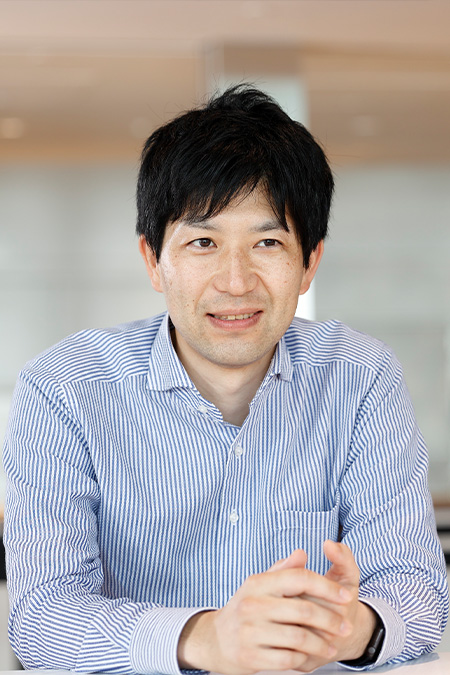
- Takuo Takahashi (Plant Engineer Group Leader, Manufacturing Engineering & Planning Department, Isuzu Motors)
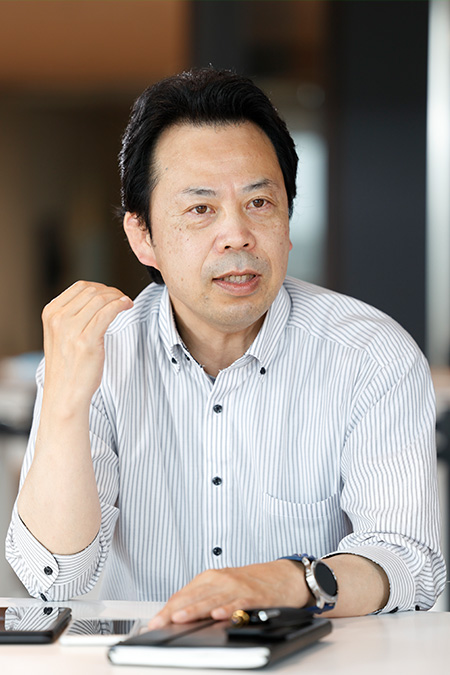
- Tsutomu Fujii (General Manager, Architectural Division, Design and Construction Department, Isuzu Estate Co. Ltd.)
Expressing the automobile manufacturer through form and texture
The layout of the floor varies. Keisuke Sonoda of Sakakura Associates Architects and Engineers, who oversaw the detailed design, says, “We designed multiple zones to accommodate different use scenarios and numbers of users, such as spaces for large group meetings around a large table, and spaces where people can work alone and concentrate. We also used different floor heights in the seating areas. At the same time, we designed the space's shape and texture with an automobile company in mind, such as using the curved surface of the car body as a motif for the counters where food is served and for the catering counter.”
Upon hearing this, Mr. Fujii points to the shiny silver ceiling above the catering counter to emphasize the point and adds, “The 'Isuzu' in Isuzu Motors originated from the 'Isuzu River', a clear stream that flows through the Inner Shrine of Ise Jingu. The motif of this ceiling reflects the surface of the Isuzu River. Rather than pursuing the lavishness of a metropolitan cafeteria, the space is a modern expression of the 'simple and sturdy' identity that is Isuzu Motors' car manufacturing ideology.”

- Above the counter, where catering food is arranged, the ceiling features a motif of the surface of the Isuzu River. Chairs are integrated under the counter so that they can be used as a bar counter as well.
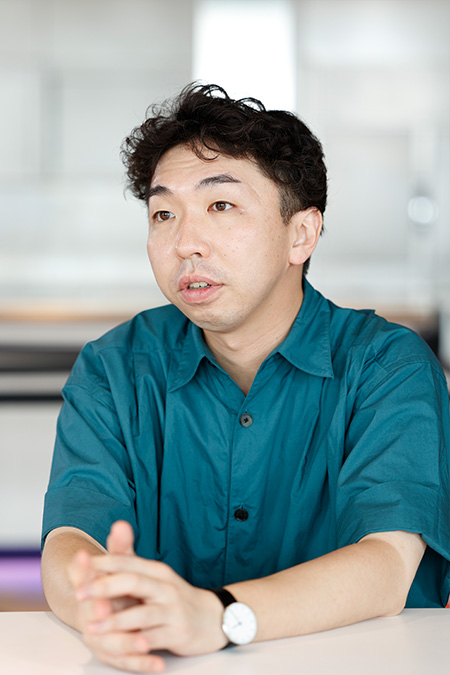
- Keisuke Sonoda of Sakakura Associates Architects and Engineers
Even refrigerators were given a subtle texture
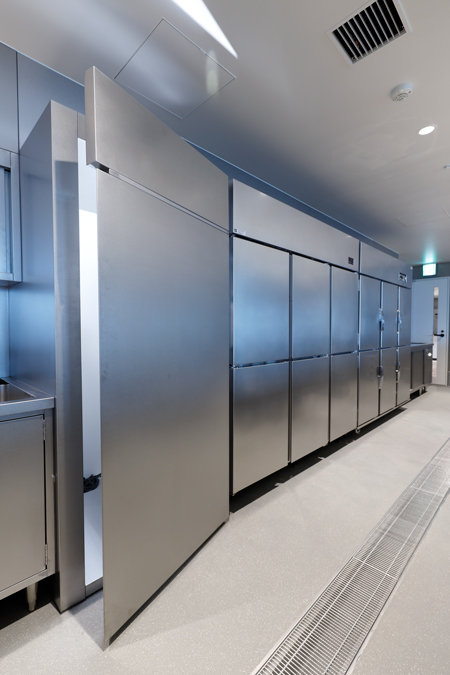
- Refrigerators and warming cabinets facing the cafeteria lane. The door in the foreground with light coming through is a pass-through to the main kitchen. All doors feature a subtle vibration finish.
Fujimak helped design the kitchen and office counters at Yokohama Terrace and also supplied much of the kitchen equipment. The kitchen also uses subtle finishes that complement the concept of the space, especially in areas visible to guests. Unlike typical specifications, the doors and other stainless steel front surfaces of refrigerators and freezers along the cafeteria's serving lane have a vibration finish (a random polishing pattern on the stainless steel surface to hide scratches).
“The stainless steel is quite beautiful, with a subtle appearance while still retaining the stainless steel's texture,” Takahashi says. “As an automotive company, many of the users are interested in materials like this, and it has proven quite popular. The evacuation door from the main kitchen to the side of the refrigerators has the same vibration finish as the refrigerators, giving the impression that it is another refrigerator. I think this is quite interesting since it blends in with the environment while retaining a whimsical element.”
Sonoda shares, “Isuzu Motors wanted a functional and clean kitchen similar to the open kitchen in the TV series 'Grand Maison Tokyo', for which Fujimak provided equipment. So we came up with the current configuration by bouncing ideas back and forth with Fujimak.” He adds a word of praise, saying, “Despite the large size of the facility, I think they did an amazing job of realizing the request.”
Next-generation digital equipment helps labor savings
There are actually two types of next-generation Fujimak equipment playing an active role behind the scenes at Yokohama Terrace.
The first is in the dishwashing area. The “finibo” robot here automatically sorts dishes after washing based on machine learning (AI) and robotics technologies. The food service industry is expected to face an even more severe labor shortage in the coming years due to Japan's declining birthrate and aging population. One of the occupations of particular concern for labor shortages is dishwashing and sorting, which requires standing in an environment that tends to be hot and humid due to the steam and heat emitted by dishwashers.
To help solve this problem in the food service industry, Fujimak developed “finibo” in collaboration with TechMagic Corporation, a developer of food-related hardware and software. Sensors are used to detect the shapes of washed dishes on a conveyor and finibo automatically picks up, sorts, and loads them in containers.
Takahashi explains, “We chose to adopt the Fujimak-proposed solution because we were eager to try cutting-edge initiatives that help solve work challenges. Although the equipment is not visible to users because it is in the dishwashing area, those who attended the private viewing were quite intrigued by it. I've been told that it has reduced workload and increased work efficiency.”
The food service outsourcing company that does the actual work has also praised finibo, saying that “finibo has helped to save manpower in the dishwashing area.”
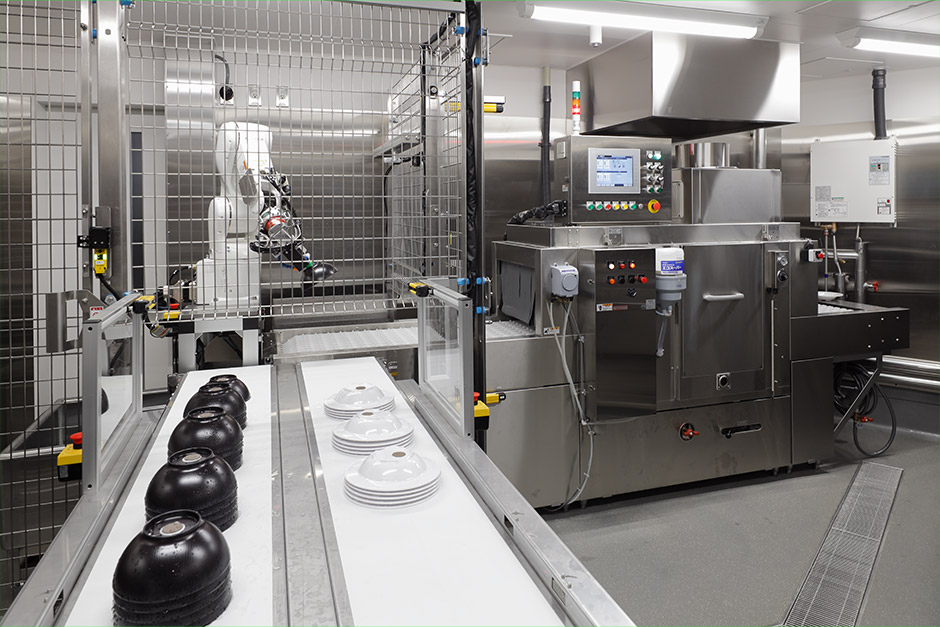
- Photo shows “finibo,” an automatic dishware sorting robot. It recognizes washed dishes coming from the dishwasher on the right by the sensor, blows off the water from their bottom rims, picks them up, and sorts them in a specific order on the collection conveyor in the foreground.
After finibo sorts the dishes into racks, an autonomous transport trolley moves them without human assistance to a distant dish sterilizer cabinet or to predetermined storage locations. Using mapped data with preplanned routes to its destination, the trolley transports loaded racks with heavy loads of up to 70 kg (depending on floor conditions) to their destination safely and without human assistance. If there is an unexpected obstacle or a person suddenly enters the path, the sensor detects it and stops immediately. The trolley will avoid the obstacle or resume driving after confirming that no one is in the way.
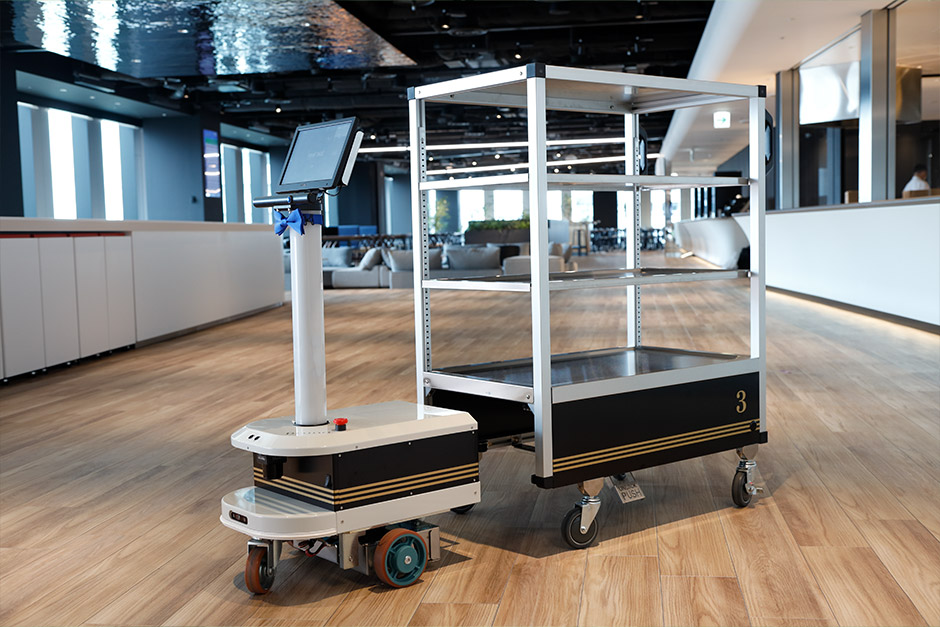
- The autonomous transport trolley. A tablet-controlled robot (right photo) is pulling the trolley (left photo). The robot and trolley can be detached.
Takahashi explains, “The kitchen at Yokohama Terrace is about 80 meters wide. The proposed system was adopted due to the need to transport dishware from one side of the two dishwashing areas located on the left and right sides of the floor to the dishware storage area on the opposite side or to various storage areas. The factory uses AGVs (automated guided vehicles), which travel back and forth along dedicated lanes. Although the system is somewhat different, the autonomous transport trolley and AGVs function similarly, so visualizing the system was simple.”
After lunch, four autonomous transport trolleys transport dishes back and forth across the floor at Yokohama Terrace. The exterior design was created specifically for Yokohama Terrace. Based on Fujimak's original drawings, the Isuzu Motors Design Center, which specializes in automobile design, designed the trolleys to have the charming appearance of a hotel concierge.

- Four autonomous transport trolleys are in operation, each designed to resemble a concierge trolley. The outer plastic molding was designed by the Isuzu Motors Design Center.
“Working with Fujimak was fun”
The building where Isuzu Motors relocated, which is also occupied by several of its affiliated companies, is a mixed-use building that also houses other tenants. Given the constraints of the building's standard specifications and timeline, it was apparently quite challenging to create a space that was both convenient to use and respectful of the company's identity. Takahashi says, “The design went through two or three iterations, but seeing the finished space, I think this was the only functionality and design that made sense. The responsiveness of the Fujimak staff was also outstanding.”
Fujii adds, “Fujimak is much more than just a kitchen equipment manufacturer, and we appreciated how they understood the construction situation and worked flexibly with us. To meet the construction schedule for the office building, the specifications changed several times, but Fujimak worked tirelessly with us, including coordinating work with the general contractor. I can honestly say that it was fun to work with the people at Fujimak.”
Sonoda added, “When the plan changes, it changes not only the floor but also the kitchen design. But Fujimak staff responded quickly every time, which was incredibly helpful.”
All three of those interviewed commented on how happy it made them feel to hear users say things like, “What a great atmosphere!” Yokohama Terrace is sure to endure as a space where many people gather to replenish their energy, interact, and generate meaningful ideas, all of which will contribute to Isuzu Motors' efforts to create its unique, never-ending stream of new products and services.
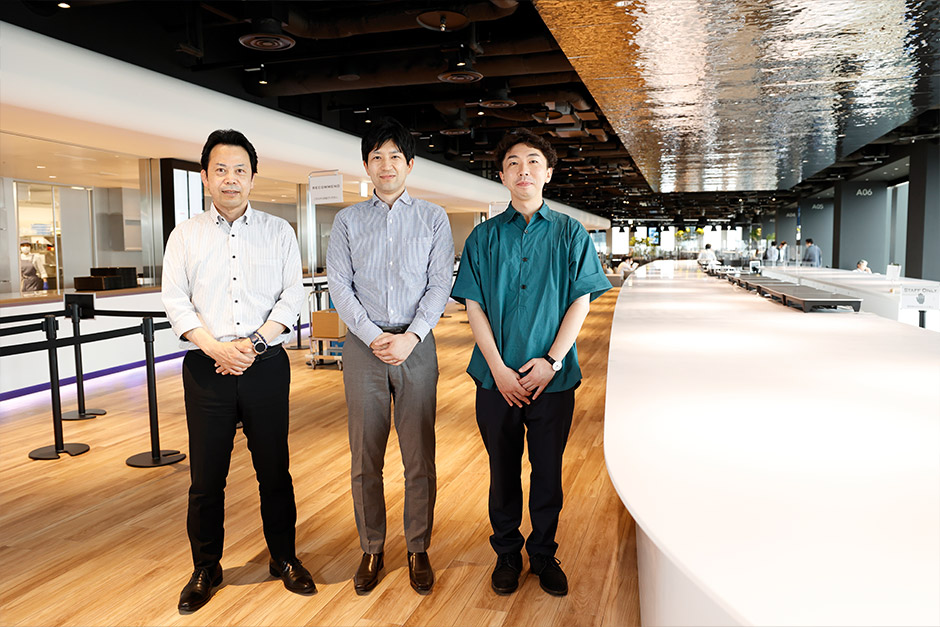
- From left: Fujii, General Manager at Isuzu Estate Co., Ltd.; Takahashi, Group Leader at Isuzu Motors; Sonoda of Sakakura Associates Architects and Engineers
Related Products
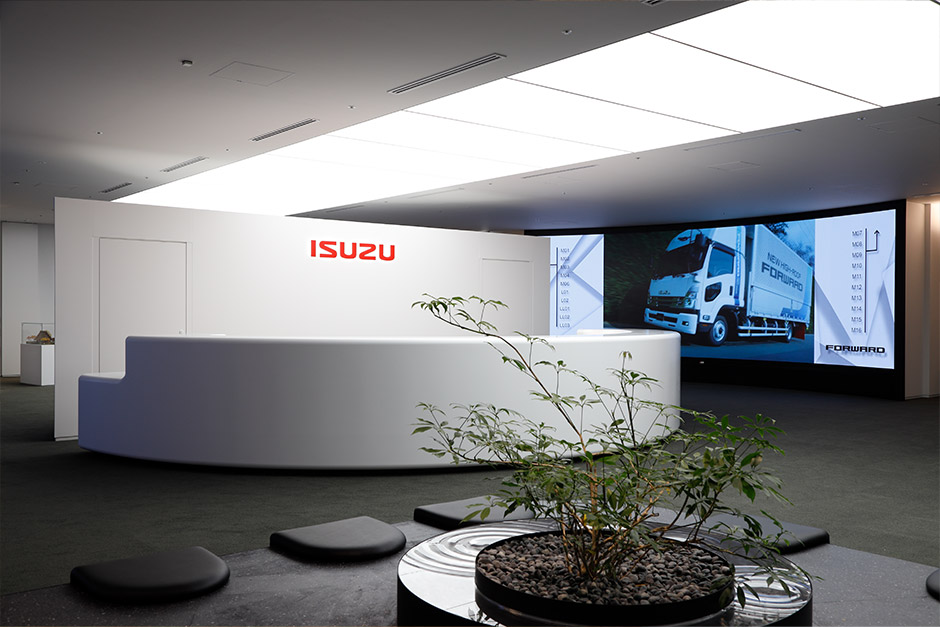
| Facility name | Isuzu Motors Headquarters |
|---|---|
| Address | Yokohama Gate Tower, 1-2-5 Takashima, Nishi-ku, Yokohama City |
| Established | May 2022 |
| Website | https://www.isuzu.co.jp/ |

